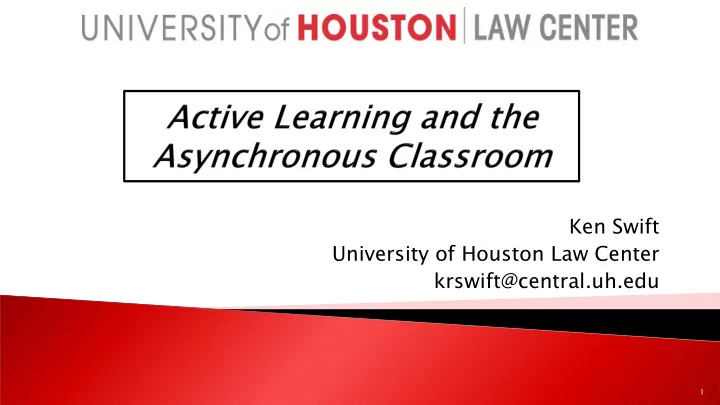

Ken Swift University of Houston Law Center krswift@central.uh.edu 1
The Seven Principles for Good Practice in Legal Education Good Practice in Legal Education: 1. Encourages student-faculty contact 2. Encourages cooperation among students 3. Encourages active learning 4. Gives prompt feedback 5. Emphasizes time spent on tasks 6. Communicates high expectations 7. Respects diverse talents and ways of learning 2
The Seven Principles for Good Practice in [Asynchronous Online] Legal Education Good Practice in Legal Education: 1. Encourages student-faculty contact 2. Encourages cooperation among students 3. Encourages active learning 4. Gives prompt feedback 5. Emphasizes time spent on tasks 6. Communicates high expectations 7. Respects diverse talents and ways of learning 3
Stanford Teaching Commons: “Active learning” means students engage with the material, participate in the class, and collaborate with each other. Don't expect your students simply to listen and memorize; instead, have them help demonstrate a process, analyze an argument, or apply a concept to a real-world situation. 4
Active e Learning ing 5
Can an aynchronous online course provide a meaningful and effective active learning experience for law students? Doctrinal/Case Law Skills 6
1. 500+ Questions about the case law • Procedural history, key facts, black letter law, court’s reasoning 2. Short answer questions and problems • Small group chat rooms 3. Longer, exam style questions 7
• Minimal amount of the type of questions used in the doctrinal course • Individual exercises emphasizing drafting and other skills • Small Group Projects and Exercises 8
Small Group Projects and Exercises Pros: • Students have time to consider and react to ideas and concepts • Results usually exceed the depth and quality of in-class exercises. Cons: • Timely participation is difficult to monitor and enforce • Students miss out on learning nonverbal cues in a professional setting 9
Measuring actual learning versus feeling of learning in response to being actively engaged in the classroom, https://www.pnas.org/content/116/39/19251 (2019) College Active Learning Websites: https://cft.vanderbilt.edu/guides-sub-pages/active-learning/#evidence (Vanderbilt) http://www.crlt.umich.edu/active_learning_introduction (Michigan) https://cei.umn.edu/active-learning (Minnesota) https://teachingcommons.stanford.edu/resources/learning-resources/promoting- active-learning (Stanford) 10
Ken Swift University of Houston Law Center krswift@central.uh.edu 11
Recommend
More recommend